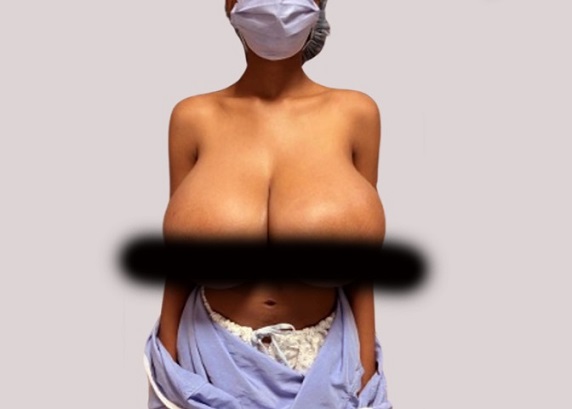Unexplained Breast Growth After Pfizer COVID-19 Vaccine, a Unique Case of Gigantomastia
Nikhil Prasad Fact checked by:Thailand Medical News Team Jan 16, 2025 11 months, 2 days, 15 hours, 1 minute ago
Medical News: What Is Gigantomastia?
Gigantomastia is an exceedingly rare medical condition characterized by rapid and extreme growth of breast tissue. While the causes are not completely understood, medical science attributes it to three main factors: idiopathic (spontaneous and without known cause), hormonal imbalances, or as a reaction to certain drugs. Recent attention has turned to reports of individuals experiencing breast growth after receiving the Pfizer COVID-19 vaccine, a phenomenon dubbed on social media as the
"Pfizer boob job."
 Unexplained Breast Growth After Pfizer COVID Vaccine, a Unique Case of Gigantomastia
Unexplained Breast Growth After Pfizer COVID Vaccine, a Unique Case of Gigantomastia
Although the claims have largely been anecdotal and unsupported by large-scale studies, there has been at least one documented medical case where breast growth occurred following vaccination. This
Medical News report will delve into the details of this extraordinary case and explore the potential medical underpinnings of such occurrences.
The Case at a Glance
The patient, a 19-year-old woman from Toronto, experienced rapid breast growth beginning one week after receiving her first dose of the Pfizer COVID-19 vaccine. The study, led by researchers from the Temerty Faculty of Medicine at the University of Toronto and Women’s College Hospital, detailed her journey from initial symptoms to definitive surgical intervention.
Before vaccination, the patient was healthy, with no notable medical history or hormonal imbalances identified during routine bloodwork. Following her first vaccine dose, she reported tingling sensations in her breasts. This progressed to significant bilateral breast enlargement that worsened after the second dose. Over six months, her breast size grew from a B cup to a triple G.
Physical examinations and imaging revealed dense, warm, and edematous breast tissue but no evidence of malignancy or infection. Despite trials of medications like steroids and antibiotics, the symptoms persisted, leaving surgical intervention as the only viable option.
What Did the Medical Investigation Show?
The research team employed a battery of diagnostic tests, including breast ultrasounds and computed tomography scans, to identify the cause of the enlargement. Imaging showed diffuse bilateral breast enlargement with mild lymph node involvement in the armpits. Core biopsies suggested fibroepithelial lesions, potentially consistent with conditions like fibroadenoma or pseudoangiomatous stromal hyperplasia (PASH).
PASH, a condition marked by excessive fibrous tissue in the breast, is rare and typically linked to hormonal imbalances involving estrogen and progesterone. This case is particularly notable as it is the first documented instance associating PASH-related gigantomastia with a vaccine.
The Path to Surgical Treatment
Given the significant and ongoing breast growth, the patient’s surgical team opted for a bilateral reduction mammoplasty. This surgery was performed eleven months after her initial
vaccine dose when breast growth had stabilized. During the procedure, surgeons removed approximately 3.6 kilograms of breast tissue. The operation, however, was complicated by significant blood loss due to increased vascularity in the affected tissues. The patient required blood transfusions during her hospital stay.
Pathological analysis of the excised tissue confirmed the presence of dense breast glandular tissue interspersed with PASH regions, solidifying the diagnosis. Despite the challenges, the surgery successfully reduced the patient’s breast size to a double D cup.
The Recovery Journey
Postoperative recovery was not without complications. On the third day after surgery, the patient developed a high fever and chest pain, prompting concerns about infection, transfusion reactions, or other complications. However, extensive evaluations ruled out these issues, and her condition stabilized following further medical management, including intravenous iron supplementation.
At a five-month follow-up, the patient’s condition remained stable. While some minor issues such as breast asymmetry and areolar discoloration persisted, there was no recurrence of breast growth. Surgeons were exploring the possibility of additional procedures to address cosmetic concerns.
Implications and need for Further Research
The patient’s case highlights the complex interplay between vaccines and immune or hormonal responses in the human body. It raises important questions about rare adverse events that might go unnoticed without thorough investigation. While the temporal relationship between the Pfizer vaccine and the onset of gigantomastia does not prove causation, it underscores the need for more comprehensive studies to explore potential links.
PASH-related gigantomastia remains poorly understood, with fewer than 20 documented cases worldwide. Existing classification systems for gigantomastia do not account for PASH or its unique characteristics. Researchers argue that a more detailed classification system, including timelines and tissue-specific changes, could aid in better diagnosis and management of such conditions.
What Can We Conclude?
This case serves as a reminder of the importance of listening to patient concerns and investigating unusual medical presentations. The patient believed that her condition was linked to the Pfizer COVID-19 vaccine, a concern that was initially dismissed by healthcare providers. This dismissal led to delays in diagnosis and treatment, as well as erosion of trust in the healthcare system.
From a scientific standpoint, the case underscores the need for vigilance in identifying and studying rare vaccine side effects. While vaccines are overwhelmingly safe and effective, cases like this illustrate the need for robust post-marketing surveillance and open communication between patients and providers.
The conclusions drawn from this case are both detailed and significant. First, it emphasizes the importance of considering all potential causes of rare medical conditions, even when they challenge conventional understanding. Second, it highlights the necessity of patient-centered care and the role of clinicians in addressing concerns with empathy and diligence. Finally, it points to the critical need for further research into PASH and its triggers, as well as any potential links to vaccines.
The study findings were published in the peer-reviewed journal: Plastic and Reconstructive Surgery Global Open.
https://journals.lww.com/prsgo/fulltext/2024/12000/the__pfizer_boob_job___a_case_of_unexplained.52.aspx
For the latest COVID-19 News, keep on logging to Thailand
Medical News.
Read Also:
https://www.thailandmedical.news/news/despite-emerging-dangers-of-breast-implants,-more-women-are-having-them
https://www.thailandmedical.news/news/australian-scientists-warn-of-rising-advanced-breast-cancer-cases-in-the-current-covid-19-era
https://www.thailandmedical.news/news/covid-19-s-effect-on-breast-cancer-cells
https://www.thailandmedical.news/news/breaking-sars-cov-2-causes-aggressive-breast-cancer-progression-and-manipulates-tissue-stem-cells-in-the-tumor-microenvironment
https://www.thailandmedical.news/news/covid-19-news-sars-cov-2-is-likely-an-oncogenic-virus-that-will-cause-lung,-colorectal,-oral,-pancreatic-and-breast-cancers-in-the-long-term
